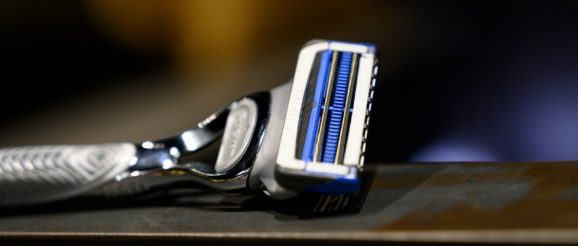Gillette’s Latest Innovation Is Removing Blades From Razors

Every couple of years, Gillette reveals the latest breakthrough in shaving technology. That has often involved adding more blades to its razors. More blades must equal a better shave, right?! One, two, three, four, five plus an extra one hidden on the back—the company has done it all. But now, after decades of famously adding all those extra blades to its razor cartridges, Gillette is removing them.
Meet the new Gillette SkinGuard Sensitive. It looks a lot like the last huge razor innovation from Gillette, the Fusion5 ProShield, except instead of featuring five blades, it has just two. Where the other three blades would have been in other Gillette razor cartridges, there’s “new SkinGuard technology,” which is essentially a blue piece of slotted plastic that drags along your face during a shave. It’s supposed to reduce skin irritation.
But don’t feel like Gillette is skimping on those two blades. According to the company, they’re “two optimally placed low cutting force (LCF) blades” that include “Gillette’s sharpest edges with [its] most advanced coatings.” These breakthroughs were announced at the Gillette Global Innovation Summit in downtown Manhattan on Wednesday, where there was a dermatologist who gave a presentation on skin irritation and showed a number of relatively graphic illustrations of a razor blade pulling a hair follicle out a man’s face. This was hilarious because it looked an awful lot like the Gillette Mach 3 commercial from the late 90s that showed how three blades were better than two. Not any more, says Gillette.
I tried shaving with the new two-bladed Gillette SkinGuard Sensitive razor a few minutes ago. It did not feel too much different than the two-blade Gillette razor my gym gives away for free. If anything, I’d say that it irritated my skin a little bit more than the Fusion blades I use at home. Gillette might say that the SkinGuard isn’t for me, since the company’s executives stressed again and again that it’s a special kind of razor for a special kind of guy. What’s wacky to me is that I think this sales pitch will work on a lot of people.
To be honest, I’m not even mad about the twisted marketing strategy. If an American shaving company has the guts to spend 20 years convincing everyone that its razor blades are better because they have more blades and then, one day, hold a Global Innovation Summit and unveil a product that looks like something from 30 years ago, I’m impressed. Gillette now says that it spent three years developing the SkinGuard technology so that it would have a product that appealed specifically to guys with sensitive skin. Fewer blades would irritate the skin less, the company says. This is after Gillette kept adding more blades to its razor, and everyone made fun of it for doing so. Philips even made a mocking TV commercial:
Here’s the funniest part, though. Gillette’s new SkinGuard and its two blades will cost $8 for a handle and one cartridge. Four additional cartridges will cost $18 through Gillette’s razor blade subscription service. The three-blade Mach3 is $10 for four cartridges. That means the two-blade Gillettee razor costs almost twice what the three-blade one costs. Put differently, you can buy the Mach3 for almost half the price of the SkinGuard and get 50 percent more blades. Again, it’s quite the marketing strategy!
Gillette’s definition of innovation is creative, at best. This has been the case for years, as the company continues to come up with reasons for men and women to buy new types of razor blades. A few years ago, it was a spring-loaded hinge device called the FlexBall that was supposed to keep you from missing spots. Before that, it was a battery-powered device called the Fusion Power that vibrated when you shaved. The shaking was supposed to cut the hairs more easily or something. It’s been a dozen years since Gillette released the original five-bladed Fusion razor, and it’s been a full two decades since the launch of the Mach3 and its triple-blade design. So if, to Gillette, innovation has historically meant adding things to its razors, now it means taking them away.
None of this makes it easier to figure out which razor isn’t going to cut up your face or legs or whatever you like to shave. The thing really worth considering is that innovation can be a tricky word, when you’re talking about basic goods like razors. At the end of the day, Gillette’s job is to talk you into thinking you need the new thing that it’s selling. In this case, the new thing looks a lot like the old thing, because it’s all marketing. It’s up to you to buy into it or, in this case, just laugh about it.
